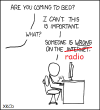Antonio DiPasquale
Filing Flight Plan
- Joined
- May 13, 2022
- Messages
- 11
- Display Name
Display name:
FlyingChemist
I was on an IFR flight plan today from KONT to KSQL and while on the cleared segment PIRRO V186 DARTS V459 LHS GMN AVE, I was given a very small shortcut to cut the corner by SoCal Approach before arriving at DARTS - "Direct LHS, resume own navigation". I read back "Direct LHS" as I though the "resume own navigation" was superfluous since I was not on a radar vector. The controller responded with a stern "NO! Direct LHS, resume own navigation". I read it back verbatim this time...minus the stern NO!, of course.
The PCG states: RESUME OWN NAVIGATION - a term used by ATC to advise a pilot to resume his/her own navigational responsibility. It is issued after completion of a radar vector or when radar contact is lost while the aircraft is being radar vectored.
I was not on a radar vector. I was on my own navigation at the time and was given direct to a waypoint, which would be on my own navigation and not a radar vector. Was the controller just having a bad day and decided I was the next target of his ire? What else was I going to do at LHS?
The PCG states: RESUME OWN NAVIGATION - a term used by ATC to advise a pilot to resume his/her own navigational responsibility. It is issued after completion of a radar vector or when radar contact is lost while the aircraft is being radar vectored.
I was not on a radar vector. I was on my own navigation at the time and was given direct to a waypoint, which would be on my own navigation and not a radar vector. Was the controller just having a bad day and decided I was the next target of his ire? What else was I going to do at LHS?

